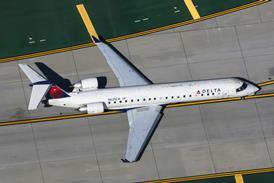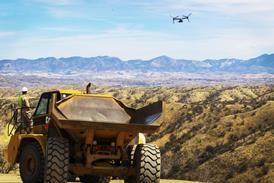Flight International experienced a short flight in the BA609 simulator during a visit to the VMSIL on the eve of the first flight. The BA609's primary controls - cyclic stick, power (collective) lever and yaw pedals - are the same as in any helicopter. Flap and landing gear handles are mounted on the forward panel between the crew stations, and engine controls are on the overhead panel.
The nacelle controller is at the front of the power lever and is a four-position thumb switch, spring-loaded to aneutral position. When converting to helicopter mode the pilot can raise the nacelles, at 3°/s, to the upper detent range of 75° to 95° (5° aft of vertical). Within that range the pilot can manually control nacelle angle until entering the hover at 90°.
For aeroplane mode, detents at 75°, 60° and 0° (fully forward) allow the pilot, with a series of pushes, to lower the nacelles at 3°/s. The nacelles can be stopped anywhere between any of the detents by touching the switch in the opposite direction. A fast reconversion mode, activated by overriding a rear force detent, brings the nacelles back to 95° from any position at 8°/s. This accommodates emergencies such as a double engine failure and allows quick deceleration. During conversion to aeroplane mode, downstop loading prevents the nacelles applying excessive forces to the structure.
The pilot's primary multifunction display provides, as well as conventional flight information, tiltrotor-specific data such as nacelle angle. An arc on the perimeter of the round-dial airspeed presentation adjusts with nacelle position to indicate the allowable speed range, or conversion "corridor". If conversion speed limits are exceeded, the airspeed numbers and indicator needle turn red. As well as protecting nacelle control limits, this reduces the pilot workload required to remain within the operational conversion corridor.
First impressions of the simulator were that the BA609 had predictable flying characteristics. Take-off to the hover was smooth and required minimal yaw-pedal input. It was simple to co-ordinate the transition into forward flight and, although converting to hover mode for landing was a little more troublesome, this can be put down to lack of practice. Project pilot Roy Hopkins says "conversions are very easy to do precisely, after some practice in the simulator and then trying a few in the aircraft itself. The nacelle control is a very powerful tool that also allows you to regulate speed, while taxiing either on the ground or in the air, and can be used to set a level attitude, regardless of centre of gravity."
Bell Agusta is convinced pilots will like the BA609. Over 100h of pilot-in-loop simulator testing have been completed, covering inflight tasks ranging from out-of-ground-effect hovers to stalls and recoveries. Hopkins says both the XV-15 prototype andV-22 have proven "easier [to fly] than most rotorcraft", because their displaced rotor configurations make them less sensitive to gusts in the helicopter and conversion modes.
In aeroplane mode, Hopkins says, the tiItrotor flies similarly to a stable turboprop. "Hopefully the real 609 will fly like the simulator, which has such good handling qualities that non-pilot engineers can fly it in benign conditions," he says.
Source: Flight International























